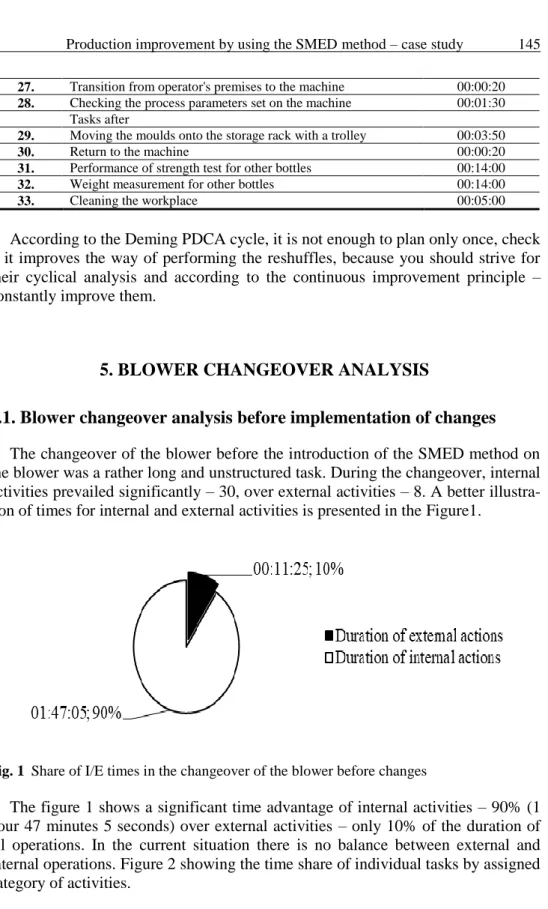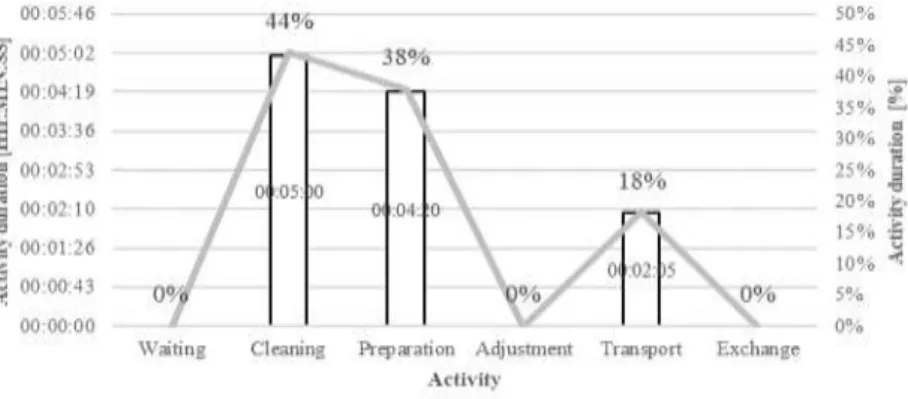PRODUCTION IMPROVEMENT BY USING
THE SMED METHOD – CASE STUDY
Mariusz Salwin*, Jan Lipiak* and Piotr Wałachowski*
* Faculty of Production Engineering, Institute of Production Systems Organization, Warsaw University of Technology, Warsaw, Poland, E-mail: mariusz.salwin@onet.pl
Abstract The article presents definitions of Lean Management. One of the methods of Lean idea,
SMED, or Single-Minute Exchange of Die, is described in detail. The aim of this article is to present the implementation of the SMED method on the example of a PET bottle blowing machine and to show the benefits of using the SMED method in production. The influence of changeover times on the production process was analysed and evaluated according to selected measures of effectiveness of implemented measures. The work consists of six parts. The first part is an introduction, the second and third part is a description of the definitions of lean management and SMED. The fourth part of the article is the implementation of the SMED method, the fifth part is the analysis of rearmament of a PET bottle blow moulding machine. The last part of the paper are conclusions.
Paper type: Case Study
Published online: 15 April 2019
Vol. 9, No. 2, pp. 137–152
DOI: 10.21008/j.2083-4950.2019.9.2.7 ISSN 2083-4942 (Print)
ISSN 2083-4950 (Online)
© 2019 Poznan University of Technology. All rights reserved.
1. INTRODUCTION
Today's globalization forces manufacturing companies to compete with each other in the struggle for every potential customer. It is often the case that compa-nies use their resources inefficiently and as a result there is a waste that leads to financial losses for the companies. Such a situation makes the future of the com-pany uncertain and in order to maintain or strengthen its market position it is nec-essary to take steps to improve the current situation. Very often companies decide, among other things, to invest money in new technologies, however, in the era of globalization, it is believed that we should strive for continuous excellence in order to survive on the market and ensure continuous development of the company. The use of production management methods known from literature for multi-assortment production often did not meet the requirements of production flexibility, therefore there is a growing tendency to implement Lean solutions, which do not require significant financial outlays for companies, as shown in this article.
2. LEAN MANAGEMENT CONCEPT
Lean management is an idea that stems from Toyota's way of thinking and act-ing. This approach assumes an increase in the productivity of resources by elimi-nating all kinds of waste in the company, production of products that the customer expects in the right amount and time, and functioning in all areas of the company's activity (Parkes, 2015; Szatkowski, 2014; Holweg, 2016).
Lean management means that a company achieves such an efficiency that it will make it flexible, i.e. able to adapt to the conditions of a changing environment, as well as resilient, i.e. responsive dynamically and quickly to changes (Romaniuk, 2018; Czerska, 2009; Womack & Jones, 1994).
The idea of Lean management is based on a tension of principles: • the determination of the value,
• identification of the value stream, • product flow,
• the 'suction' principle, • striving for perfection.
The implementation of the principles of Lean requires the implementation of many characteristic tools that will enable the elimination of waste of various types. In practice, these techniques are usually referred to as Lean Toolbox. In this set there are such solutions as Just-in-Time, suction system, Kanban technique, mixed production model, kaizen approach, standardization, value stream mapping and methods: SMED, TPM, 5S and Poka-Yoke (Szatkowski, 2014; Abdallah, Dahiyat & Matsui, 2018; Nowotarski & Pasławski, 2018).
3. SMED METHOD – DEFINITION
SMED is the abbreviation for Single-Minute Exchange of Die, i.e. changeover in one-digit number of minutes. This is a method that is designed to allow the ma-chine to be converted and set up in less than ten minutes. This method was devel-oped to improve the processes of machine reconfiguration as well as tool setting in machines. The principles of the SMED concept can be applied to improve all types of processes (Carrizo Moreira & Torres Garcez, 2013; Kubik, 2010; Sony, 2018).
This methodology makes it possible to meet the expectations related to quick rebuilds of production lines. Especially in the case of complex and variable produc-tion lines, as well as in the case of innovative methods of producproduc-tion organisaproduc-tion, which are increasingly used in practice, such as continuous flow (Sony, 2018; Godina, Pimentel, Silva & Matias, 2018; Boran & Ekincioğlu 2017).
SMED is a method based on searching for and using solutions that give the pos-sibility of converting and rearming the machine, from production of one product to production of another in a very short time (Boran & Ekincioğlu, 2017; Singh, Singh & Singh, 2018; McIntosh, Culley, Mileham & Owen, 2000; Filla, 2016; Łunarski, 2009).
The SMED approach shall be implemented in four successive steps:
• Stage 0 – no distinction is made between external and internal operations (at this stage, the rearmament process is recorded in detail).
• Stage 1 – separation of activities that take place during the conversion to external activities (which take place when the machines are in operation), internal activities (which take place when the machines are not in opera-tion) and unnecessary activities (which are performed incorrectly during the conversion).
• Stage 2 – at this stage unnecessary activities are eliminated and internal preparation is transformed into external one.
• Stage 3 – improving preparation operations by using new design solutions that make it easier to position and fix handles and tools on the machine (Shingo, 1985).
4. IMPLEMENTATION OF THE SMED METHOD ON
A SELECTED PRODUCTION SITE
The example of SMED method implementation was presented on the example of PET bottle blowing machine. Prior to the start of the project, members of the team were appointed who were responsible, as appropriate, for:
• carry out the conversion of the machine,
• analysing the current situation and looking for better solutions.
The following steps present the individual SMED components for the machine in question.
4.1. Stage 0 – status quo analysis
The analysis of the current state of affairs was based on a thorough analysis of the activities of the machine rearmament with a detailed description of the name of each task and the calculation of the time of performing particular operations. The following table 1 shows a list of all the operations that have been noticed dur-ing the changeover.
Table 1 Analysis of the blower's set-up film
Step
number Name of tasks
Time of operation [HH:MIN:SS] 1.
Emptying the machine from previous production (writing down the counter status and deleting the counter on the panel)
00:01:45
2. Preparation of ampoule wrenches 00:00:30
3. Switching to preform tray 00:00:20
4. Placing empty baskets on pre-forms 00:01:55
5. Backfilling of old pre-forms from the hopper 00:05:10
6. Exporting old pre-forms 00:02:10
7. Transition from the pre-forms to the mould change
stand 00:00:25
8. Closing the mould cooling water supply to the machine 00:00:45
9. Wearing gloves 00:00:15
10. Transition to the moulded shelf 00:00:25
11. Take-up of the required forms 00:03:35
12. Bringing moulds into the machine 00:00:40
13. Switching to operator premises for cleaning and paper
towels 00:00:40
14. Return to the machine 00:00:20
15. Removing old moulds and setting up new ones 00:20:00
16. Moving the moulds onto the storage rack with a trolley 00:03:50
17. Return to the machine 00:00:20
18. Cleaning of rods 00:14:00
19. Mould disinfection 00:09:00
20. Going to the machine panel to switch it on 00:00:15
21. Waiting for mould positioning 00:01:00
22. Selecting a new recipe 00:01:10
23. Waiting for the recipe to be loaded (empty bottle
preparation for strength test) 00:02:00
24. Transition from machine panel to preform 00:00:20
25. Preparation of new pre-forms for production 00:03:50
27. Waiting for the stove to warm up 00:02:00
28. Batch production - speed setting of the machine 00:01:05
29. Collection of bottles for strength test 00:01:05
30. Transition to a bottle strength testing device 00:00:35
31. Perform strength test for bottles from each machine
seat. 00:15:00
32. Going to machine panel - Referring to bottle box 00:00:30
33. Production of control lot for bottle weighing test 00:01:00
34. Access to operators' premises 00:00:20
35. Weight measurement of bottles from each machine seat 00:15:00
36. Transition from operator's premises to the machine 00:00:20
37. Checking the process parameters set on the machine 00:01:30
38. Cleaning the workplace 00:05:00
The analysis of the film allowed to distinguish 38 activities. The total duration of the rearmament was 1 hour, 58 minutes and 30 seconds.
4.2. Stage 1 – dividing activities into internal and external
The table 2 shows the division of the activities into external and internal. In or-der to better unor-derstand the nature of the operations, each activity is assigned one of the following categories: (1) W – waiting, (2) C – cleaning, (3) P – preparation, (4) A – adjustment, (5) T – transport, (6) E – exchange.
Table 2 Division of the blower's refitting operations into internal and external ones
Step number Internal or external Category Step number Internal or external Category 1. I P 20. I T 2. E P 21. I W 3. I T 22. I P 4. I P 23. I P 5. I P 24. I T 6. I T 25. I P 7. I T 26. I T 8. I P 27. I W 9. E P 28. I A 10. E T 29. I P 11. E P 30. I T 12. E T 31. I P 13. E T 32. I T 14. E T 33. I P 15. I E 34. I T 16. I P 35. I P 17. I T 36. I T 18. I C 37. I A 19. I C 38. E C
The table 2 shows that there are considerably more internal than external opera-tions for converting a machine. Most of them relate to preparation tasks, but there are also a lot of activities concerning transport, which indicates excessive traffic at the workplace.
4.3. Stage 2 – transformation of internal operations into external
operations, elimination of unnecessary operations
The division of activities into external and internal allowed for further analysis of armaments, i.e. transformation of internal operations into external operations and elimination of unnecessary operations. The table 3 gives an overview of all the tasks and an indication of the new nature of their implementation.
Table 3 Division of the blower's refitting operations into internal and external ones
Step
number Now After that
Step
number Now After that
1. I I 20. I I 2. E E 21. I I 3. I E 22. I I 4. I E 23. I I 5. I E 24. I Elimination 6. I E 25. I E 7. I E 26. I Elimination 8. I E 27. I I 9. E E 28. I I 10. E E 29. I I 11. E Elimination 30. I I 12. E E 31. I I 13. E Elimination 32. I I 14. E Elimination 33. I I 15. I I 34. I I 16. I E 35. I I 17. I E 36. I I 18. I Elimination 37. I I 19. I Elimination 38. E E
Finally, 9 activities were transformed from internal to external. Seven opera-tions were also eliminated and classified as unnecessary.
Table 4 Division of the blower's refitting operations into internal and external ones –
attentions Step
number Now After that Attentions number
11. E Elimination
There will be no need to remove the moulds from the rack, as special trolleys will be introduced into the different types of moulds.
13. E Elimination Paper towels and cleaners will be prepared together with number 2, which will be slightly elongated.
14. E Elimination Elimination of the action due to action number 13.
15. I I
Taking steps 18 and 19 into account, the time taken to complete the task will be increased, however, the introduction of moulded trolleys will allow for a little reduction in this time.
16. I E This will be done at the end of the changeover before cleaning the stand.
17. I E This will be done at the end of the changeover before cleaning the stand.
18. I Elimination
This will be done when removing old moulds and setting up new ones. The cleaning time will be reduced.
19. I Elimination
This will be done when removing old moulds and setting up new ones. The time taken to disinfect will be reduced.
24. I Elimination No more action due to action number 25 after emptying old preforms.
25. I E This will be done as soon as the old pre-forms are emptied.
26. I Elimination No more action due to action number 25 after emptying old preforms.
31. I I
The strength test will be carried out on 1 bottle as no quality problem has been identified so far. The test for the remaining bottles will be carried out once production has started.
35. I I
Weight measurement will be performed for 1 bottle as no bottle quality problem has been noticed so far. The measurement for the remaining bottles shall be made after the start of production.
4.4. Stage 3 – the improvement of individual operations
After the transformation of internal activities into external activities and the elimination of unnecessary tasks, it was decided to organize the sequence of per-forming particular operations in such a way as to eliminate unnecessary movement at the workplace and ensure better ergonomics. Some tasks have been merged into one. The table 5 shows the order in which the tasks were performed, including the division into those performed before, during and after the changeover.
The set-up time was 46 minutes and 35 seconds, while the total duration of all operations was 1 hour 40 minutes and 20 seconds. When determining the order in which particular activities were performed, attention was also paid to the manner in which they were performed. It was noted that until now the format parts had been on the shelves. The employee had to remove and transport the parts with a trolley, and then when changing the moulds he made too strong manual movements – bending down in part. In order to ensure better operator comfort when removing and attaching moulds, it was decided to introduce special swivel trolleys, which allowed to improve the ergonomics of work.
Table 5 Division of the blower's refitting operations into internal and external ones –
attentions Step number Tasks Time of operation [HH:MIN:SS] Tasks before
1. Preparation of ampoule wrenches, cleaning cloth and paper
towels 00:00:40
2. Switching to preform tray 00:00:20
3. Placing empty baskets on pre-forms 00:01:55
4. Emptying old pre-forms from the hopper 00:05:10
5. Exporting old pre-forms 00:02:10
6. Preparation of new pre-forms for production 00:03:50
7. Transition from the pre-forms to the mould change stand 00:00:25
8. Closing the mould cooling water supply to the machine 00:00:45
9. Wearing gloves 00:00:15
10. Transition to the moulded shelf 00:00:25
11. Bringing moulds into the machine 00:00:40 Tasks during
12. Emptying the machine from previous production (writing down
the counter status and deleting the counter on the panel) 00:01:45
13. Removing old moulds and setting up new ones 00:30:00
14. Going to the machine panel to switch it on 00:00:15
15. Waiting for mould positioning 00:01:00
16. Selecting a new recipe 00:01:10
17. Waiting for the recipe to be loaded (empty bottle preparation
for strength test) 00:02:00
18. Waiting for the stove to warm up 00:02:00
19. Batch production - speed setting of the machine 00:01:05
20. Collection of bottles for strength test 00:01:05
21. Transition to a bottle strength testing device 00:00:35
22. Perform strength test for 1 bottle 00:01:00
23. Going to machine panel - Referring to bottle box 00:00:30
24. Production of control lot for bottle weighing test 00:01:00
25. Access to operators' premises 00:00:20
27. Transition from operator's premises to the machine 00:00:20
28. Checking the process parameters set on the machine 00:01:30 Tasks after
29. Moving the moulds onto the storage rack with a trolley 00:03:50
30. Return to the machine 00:00:20
31. Performance of strength test for other bottles 00:14:00
32. Weight measurement for other bottles 00:14:00
33. Cleaning the workplace 00:05:00
According to the Deming PDCA cycle, it is not enough to plan only once, check if it improves the way of performing the reshuffles, because you should strive for their cyclical analysis and according to the continuous improvement principle – constantly improve them.
5. BLOWER CHANGEOVER ANALYSIS
5.1. Blower changeover analysis before implementation of changes
The changeover of the blower before the introduction of the SMED method on the blower was a rather long and unstructured task. During the changeover, internal activities prevailed significantly – 30, over external activities – 8. A better illustra-tion of times for internal and external activities is presented in the Figure1.Fig. 1 Share of I/E times in the changeover of the blower before changes
The figure 1 shows a significant time advantage of internal activities – 90% (1 hour 47 minutes 5 seconds) over external activities – only 10% of the duration of all operations. In the current situation there is no balance between external and internal operations. Figure 2 showing the time share of individual tasks by assigned category of activities.
Among the internal activities, the most time is spent on activities related to the preparation for changeover – 50% of the total time of internal operations, therefore, during the implementation of the SMED, special attention should be paid to the possibility of eliminating the given activities or performing them even before the machine is stopped. Other tasks are characterized by a much shorter time. In turn, in external activities only 3 categories of tasks were distinguished – cleaning, preparation and transport. Their duration in comparison to internal activities is much shorter.
Fig. 2 Time share of tasks by category for internal activities before changes
5.2. Blower changeover analysis after implementation of changes
The implementation of the SMED method at the blower's stand allowed to sig-nificantly reduce the time of machine changeover. The figure 4 shows the charac-teristics of time of internal and external operations after the changes.Fig. 4 Share of I/E times in the changeover of the blower after changes
The implementation of the SMED method allowed to significantly shorten the duration of internal operations – 56% compared to the situation before the changes (Fig. 1). The effect of the introduced changes is a clearly formed balance between the duration of internal and external operations. The figure 5 shows the changes that have occurred in terms of the activities performed.
Fig. 5 Time share of tasks by category for internal activities after changes
During the implementation of the SMED method, the nature of selected activi-ties was changed, the effect of which is shown in Figures 3-4. The vast majority of
activities for internal operations were included in the exchange category (64% of the total duration of internal operations) – previously most of the operations were in the preparation category, which will now be performed as much as possible be-fore the machine stoppage as external operations (76% of the total duration of ex-ternal operations).
Fig. 6 Time share of tasks by category for external activities after changes
5.3. The impact of changeover times on the production process
Reduced changeover time also improves the production process. In the tables below, two ways of presenting the percentage increase in production on an annual basis are presented.
Table 6 Increase in production on an annual basis – the first way
Specification Step Formula Calculations
Changeover time before SMED
implementation [min] A Data 119
Changeover time after SMED
implementation [min] B Data 47
Time saving [min] C A-B 72
Machine output [pcs./h] D Data 30000
Additional number of bottles produced
during the first changeover [pcs. E (D*C/60) 36000
Number of armaments per year F Data 115
Additional number of bottles produced
in the year [pcs.] G E*F 4140000
Effective working time (before SMED
Number of bottles produced annually
(before SMED implementation) [pcs. I D*H 159147500 Total number of bottles produced after
SMED implementation J G+I 163287500
Increase in production on an annual
basis K (G/K)*100% 2.54%
The first one is more detailed because when calculating the total number of bot-tles produced after the implementation of SMED it is first necessary to calculate the annual number of bottles produced before the implementation of SMED and then to the result obtained add the additional number of bottles that can be pro-duced in the time saved on changeover.
The use of the SMED method allowed for an increase in production by 2.54% compared to the previous situation.
In the second way, the total bottle production is calculated by multiplying the effective working time after SEMD implementation by the productivity of the ma-chine – much faster and simpler compared to the first method.
Table 7 Increase in production on an annual basis – the second way
Specification Step Formula Calculations
Effective working time (before SMED
implementation) [h/year] A Data 5304.916667
Effective working time (after SMED
implementation) [h/year] B Data 5442.916667
Machine output [pcs./h] C Data 30000
Number of bottles produced annually (before SMED implementation) [pcs./year]
D A*C 159147500
Total number of bottles produced
after SMED implementation E B*C 163287500
Increase in production on an annual
basis F 100%-((D/E)*100%) 2.54%
Increase in production on an annual basis F 100%-((D/E)*100%) 2.54% In the above situation, the increase in production also amounted to 2.54%. When calculating production growth through the use of SMED, a second method is much more recommended.
5.4. Improvement of selected measures of effectiveness of implemented
measures
One of the measures of the effectiveness of implemented actions, which is cal-culated after the implementation of SMED, is the so-called armament indicator -
C/O, which is calculated by dividing the total duration of armaments by the nomi-nal working time. The following table 8 shows the value of the C/O ratio before and after SMED implementation.
The introduction of changes in machine changeover resulted in a decrease in the C/O ratio from 3.79% to 1.5%. The implementation of SMED has also contributed to an increase in machine availability (by reducing time losses on changeovers). The following table 10 shows the calculation of the machine availability index before and after the implementation of SMED.
Table 8 C/O ratio
Number of machine changeovers per year
Changeover time [min] Total changeover time [min] C/O ratio Before implementation of SMED 115 119 13685 3.79% After implementation of SMED 47 5405 1.50%
Table 10 Machine availability index
Specification Step Formula
Before implementation of SMED After implementation of SMED Nominal working time
[min/year] A Data 361440 361440
Planned repairs and maintenance
[min/year]
B Data 14400 14400
Available operating
time [min/year]. C A – B 347040 347040
Loss of time [min/year] D Data 28745 20465
Effective working time
[min/year] E C – D 318295 326575
Availability [%] F E/C 91.72% 94.10%
The implementation of SMED contributed to the improvement of the machine availability rate from 91.72% to 94.10% - an increase of 2.38%.
Today's globalization is increasing rivalry among manufacturing companies. Companies strive to increase their production while trying to maintain a lower pro-duction price and the highest quality of offered products. In order to achieve this, companies are forced to carry out various process optimisations. One such way was to implement the SMED method, which is described in this article. Due to the SMED execution, the procedures of armament making on the blower were stan-dardized, which contributed to a significant shortening of the time of this operation. Reduced set-up time translated into increased availability of the equipment (de-crease in time loss), a de(de-crease in the value of the C/O ratio and an in(de-crease in an-nual production by 2.54%. In accordance with the Deming PDCA cycle, one should remember not to stop at one optimization action, but to constantly improve SMED by planning, performing, checking and implementing subsequent actions contributing to shortening machine changeover times.
REFERENCES
Parkes A. (2015) Lean Management Genesis, Management, Vol.19, No. 2, pp. 106–121. Szatkowski K. (2014) Modern production management. Procedural approach, (in Polish:
Nowoczesne zarządzanie produkcją. Ujęcie procesowe), PWN Scientific Publishing House, Warszawa.
Holweg M. (2016) The Genealogy of Lean Production, Journal of Operations Management, Vol. 25, 420–437.
Romaniuk P. (2018) Application of Lean Management in modern management public administration, Journal of Modern Science, Vol. 37, No. 2, pp. 203–218.
Czerska J. (2009) Improvement of the value stream, (in Polish: Doskonalenie strumienia wartości), Difin Publishing House, Warszawa.
Womack J.P. & Jones D.T. (1994) From Lean Production to Lean Enterprise, Harvard Business Review, Vol. 72, No. 2, p. 93–103.
Abdallah A.B., Dahiyat S.E. & Matsui Y. (2018) Lean management and innovation perfor-mance: Evidence from international manufacturing companies, Management Re-search Review.
Nowotarski P. & Pasławski J. (2018) Lean management in small and medium-sized con-struction enterprises in Poland – selected results, Przegląd Naukowy Inżynieria i Kształtowanie Środowiska, Vol. 27, No. 3, pp. 260–268.
Carrizo Moreira A. & Torres Garcez P.M. (2013) Implementation of the Single Minute Exchange of Die (SMED) Methodology in Small to Medium-sized Enterprises: A Por-tuguese Case Study, International Journal of Management, Vol. 30 No. 1, pp. 66–87. Kubik S. (2010) Rapid changeover for operators: SMED system (in Polish: Szybkie
przez-brojenia dla operatorów: System SMED), ProdPublishing Production Publishing House, Wrocław.
Sony M. (2018) Industry 4.0 and lean management: a proposed integration model and research propositions, Production & Manufacturing Research, Vol. 6, No. 1, pp. 416– 432.
Godina R., Pimentel C., Silva F.J.G. & Matias J.C.O. (2018) A Structural Literature Review of the Single Minute Exchange of Die: The Latest Trends, Procedia Manufacturing, Vol. 17, pp.783–790.
Boran S. & Ekincioğlu C. (2017) A novel integrated SMED approach for reducing setup time, The International Journal of Advanced Manufacturing Technology, Vol. 92, No. 9, pp. 3941–3951.
Singh J., Singh H. & Singh I. (2018) SMED for quick changeover in manufacturing industry – a case study Benchmarking: An International Journal, , Vol. 25, No. 7, pp. 2065–2088.
McIntosh R.I., Culley S.J., Mileham A.R. & Owen G.W. (2000) A critical evaluation of Shingo's 'SMED' (Single Minute Exchange of Die) methodology, International Journal of Production Research, Vol. 38, No. 11, p. 2377–2395.
Filla J. (2016) The Single Minute Exchange of Die Methodology in a High-Mix Processing Line, Journal of Competitiveness, Vol. 8, No. 2, pp. 59–69.
Łunarski J. (2009) Technology management. Evaluation and improvement (in Polish: Zarządzanie technologiami. Ocena i doskonalenie), Publishing House of the Rzeszów University of Technology, Rzeszów.
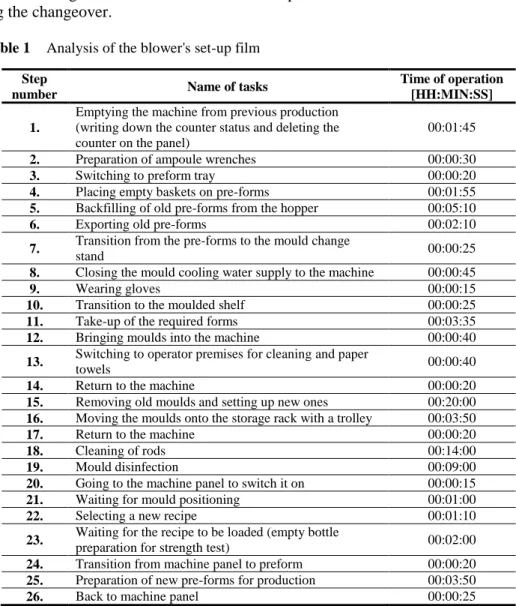
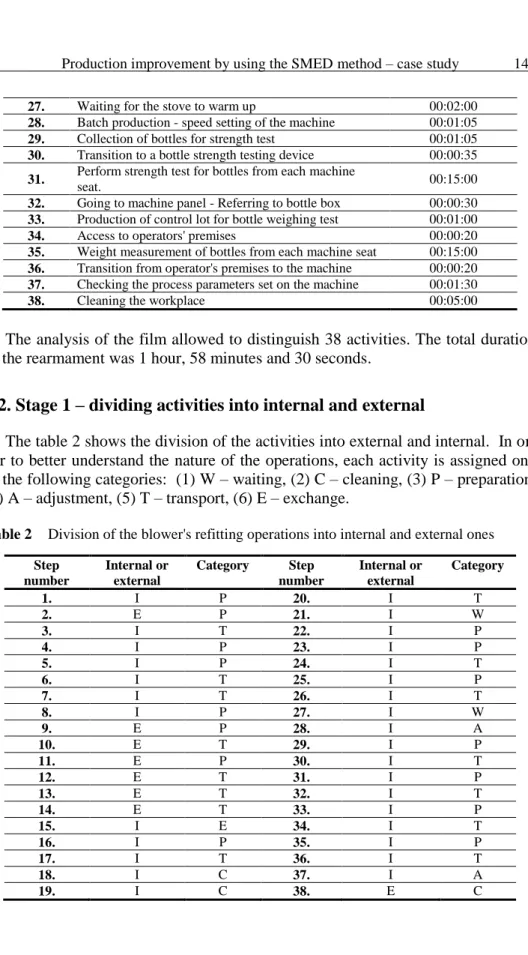
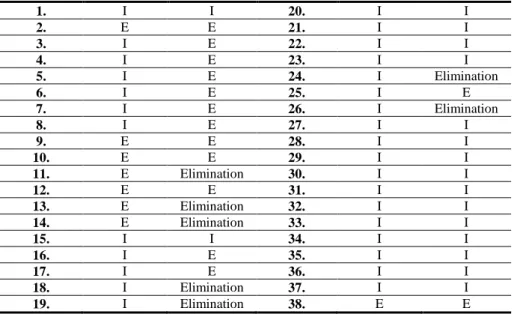
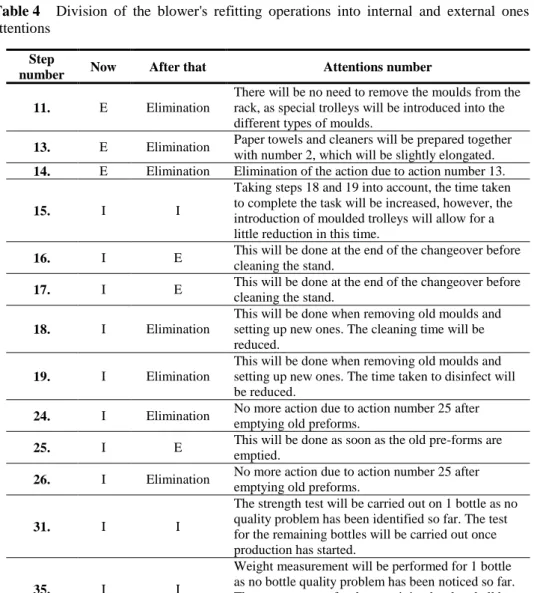
![Table 5 Division of the blower's refitting operations into internal and external ones – attentions Step number Tasks Time of operation [HH:MIN:SS] Tasks before](https://thumb-eu.123doks.com/thumbv2/9liborg/3047868.6671/8.892.173.731.488.1032/table-division-refitting-operations-internal-external-attentions-operation.webp)
